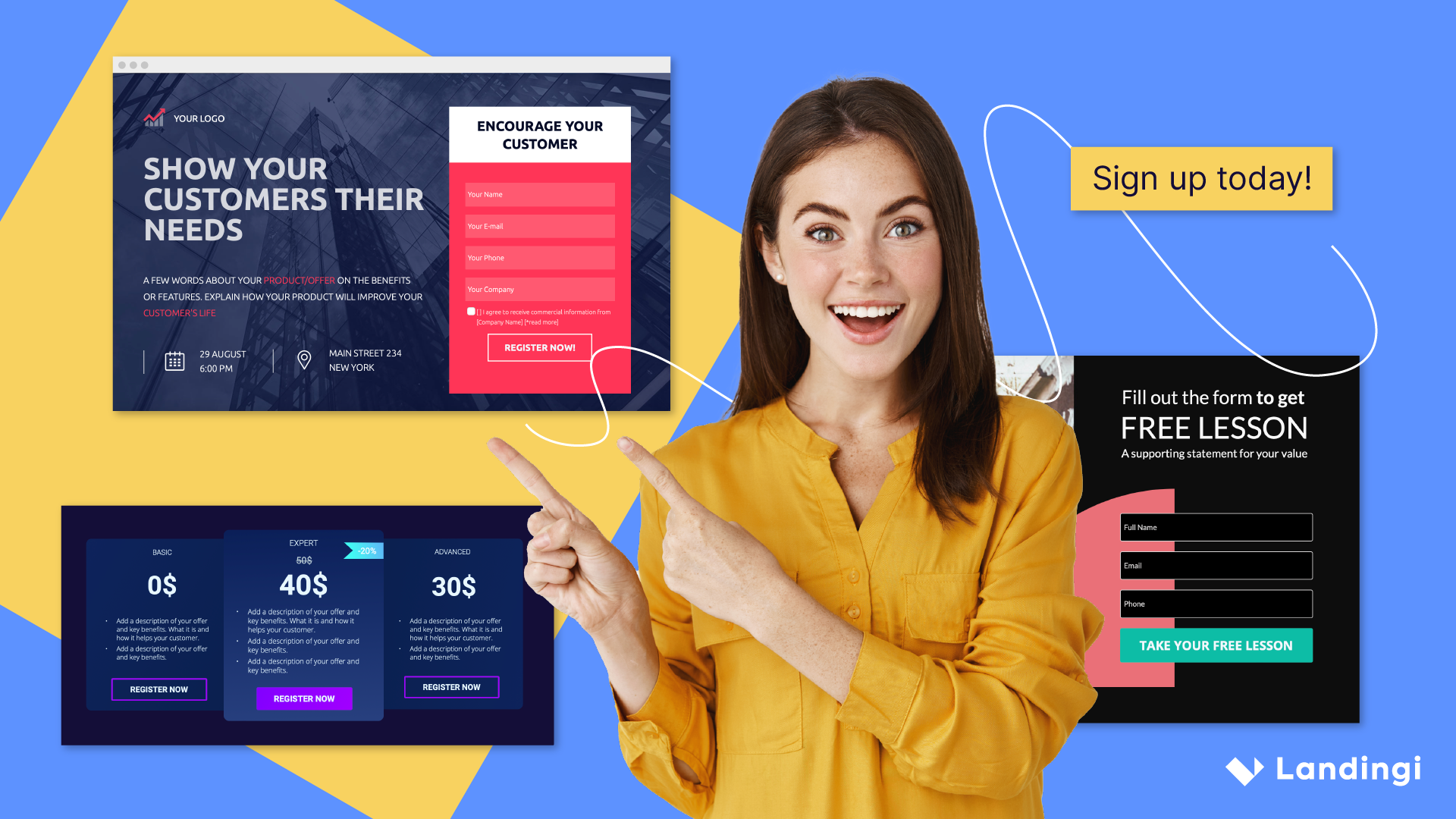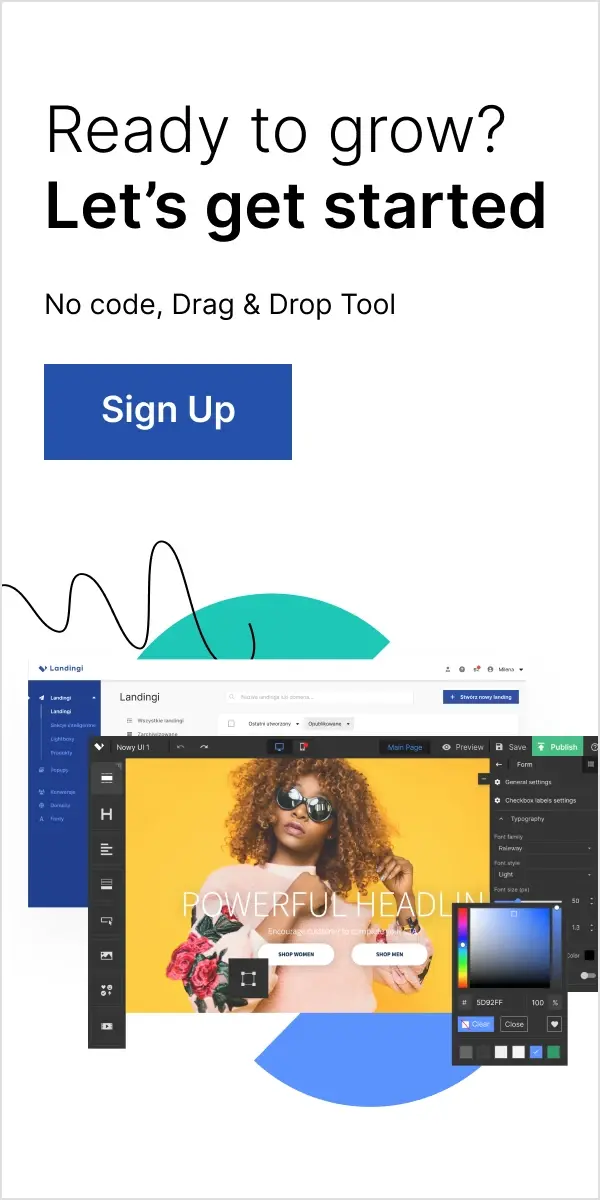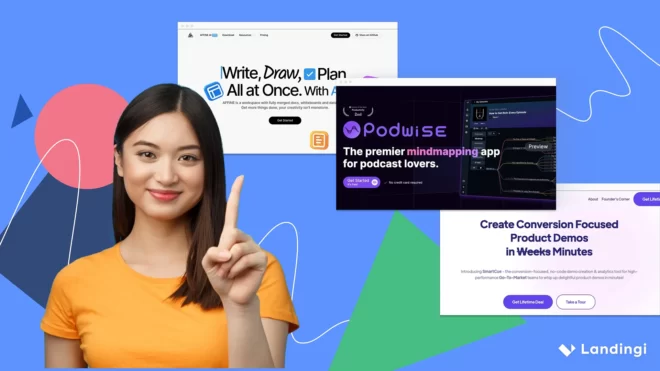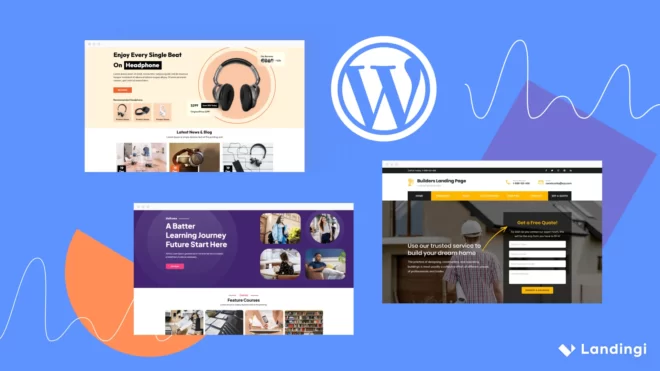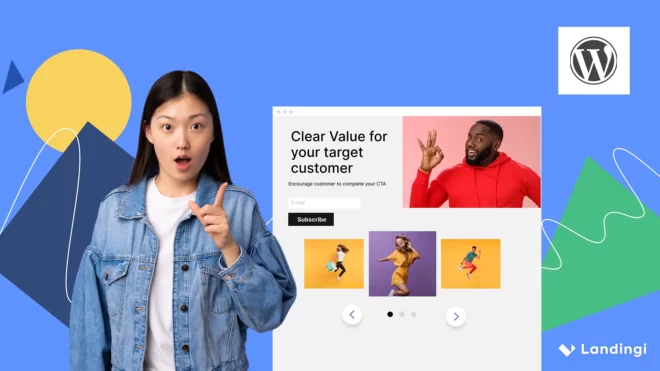The journey from a visitor to a loyal customer often begins with a single step – a sign-up landing page. These pages, also known as registration or subscription pages, are where potential leads turn into active participants in your services.
In this post, we will examine some of the most effective sign-up landing page examples and unpack why their design and strategy are instrumental in boosting conversions and overall user engagement. Furthermore, we’ll recommend you a few landing page templates you can apply to build similar pages.
Here is the full list of samples we’ll go through:
Make your sections smartable and let go of mundane manual tasks with Smart Sections! An easy way to manage bulk changes.
What is a Sign-up Landing Page?
A sign-up landing page is a dedicated web page designed specifically to capture leads by encouraging visitors to register or subscribe, typically in exchange for access to content, services, or product trials. Unlike general homepages or product pages, sign-up landing pages focus solely on lead generation, making them a critical tool in digital marketing strategies.
Why do I Need a Sign-up Landing Page?
You may need a sign-up landing page because it streamlines the user journey towards a specific action – signing up, which results in acquiring new leads. This singular focus on sign-up eliminates distractions and guides visitors directly towards providing their contact information, thus enhancing the efficiency of your conversion process. In Omnisend’s research, landing pages reached the highest CR (23%) among other sign-up forms like pop-ups, e-mails, etc. (B. Meyer, The best signup forms for high conversions, 2022).
Here are some reasons why a sign-up landing page is indispensable in your digital marketing:
- Focused Conversion Strategy: Landing pages are designed with one goal in mind, making them more effective at guiding users to take a specific action compared to a general website page.
- Effective Data Collection: They are key for gathering valuable user information, which is essential for lead nurturing and developing personalized marketing campaigns.
- Increased User Engagement: Offering something of value in exchange for user information, like a free resource or trial, can significantly boost engagement. A sign-up landing page is a perfect place to bring this idea to life.
How do I Create a Sign-up Landing Page?
To create a sign-up landing page, you will need a solid landing page builder, detailed information about your target group to meet their needs, some persuasive copy to convince them to register, and an overall design idea to make your creation appealing to the audience and ensure straightforward navigation. If you need step-by-step guidance, just dive into the list below.
1. Understand Your Audience
Know who you are targeting. Tailoring your message to the specific needs and interests of your audience is crucial for engagement. Utilize audience data and personas to guide your content strategy.
2. Craft Compelling Copy
The text on your landing page should be clear, concise, and persuasive. Highlight the benefits of your offer and use action-oriented language.
Info: Did you know that changing one word in your CTA may double the conversion rate? In the case study described by GoCardless, replacing the “Request a demo” copy on CTA with “Watch a demo” caused a 139% rise in conversion (A. Thompson, How a one word change increased product demo conversions by 139%, 2023)!
3. Design for Usability and Appeal
The design should be clean, attractive, and aligned with your brand. Ensure the page is easy to navigate and mobile-friendly, as mobile responsiveness is critical in today’s digital landscape.
4. Create a Strong CTA
A perfect CTA should be prominent and direct. It’s the most crucial element on your page, guiding users towards the desired action. Data from HubSpot shows that personalized CTAs have a 202% higher conversion rate than generic ones (A. Vora, 15 Call-to-Action Statistics You Need to Know About to Increase Your Conversion Rate, 2023).
Pro-Tip: In CTA copy, use first-person phrasing. ContentVerve reported a 90% jump in click-through rates after changing their CTA from the second-person ‘Start your free 30-day trial’ to the first-person ‘Start my free 30-day trial’ (G. Hossen, 27 Must Know CTA Statistics to Boost Your Conversion Rates, 2021).
5. Incorporate Social Proof
Though the sign-up landing should be simple and limit the visuals, you may instead use client logos can enhance trustworthiness. Many studies indicate that people trust peer recommendations over advertising.
6. Implement Analytics for Tracking
Use tools like Google Analytics, Optimizely or EventTracker to track the performance of your landing page. Analyzing user behavior and conversion rates can provide insights for continuous improvement.
7. Test and Refine
Regularly conduct A/B testing to determine which elements of your page are most effective.
10 Sign-up Landing Page Best Practices
Though they look super simple, there are plenty of rules to follow in creating high-converting landing pages for registration. Some of the core principles are listed below.
Start with Clear and Concise Headline like Unbounce
Use a headline that immediately communicates the value proposition of what you’re offering. Remind the user briefly what they will gain by registering. For example, Unbounce teases users with a promise to create landing pages “as you like it”, which means ease and user-friendliness.
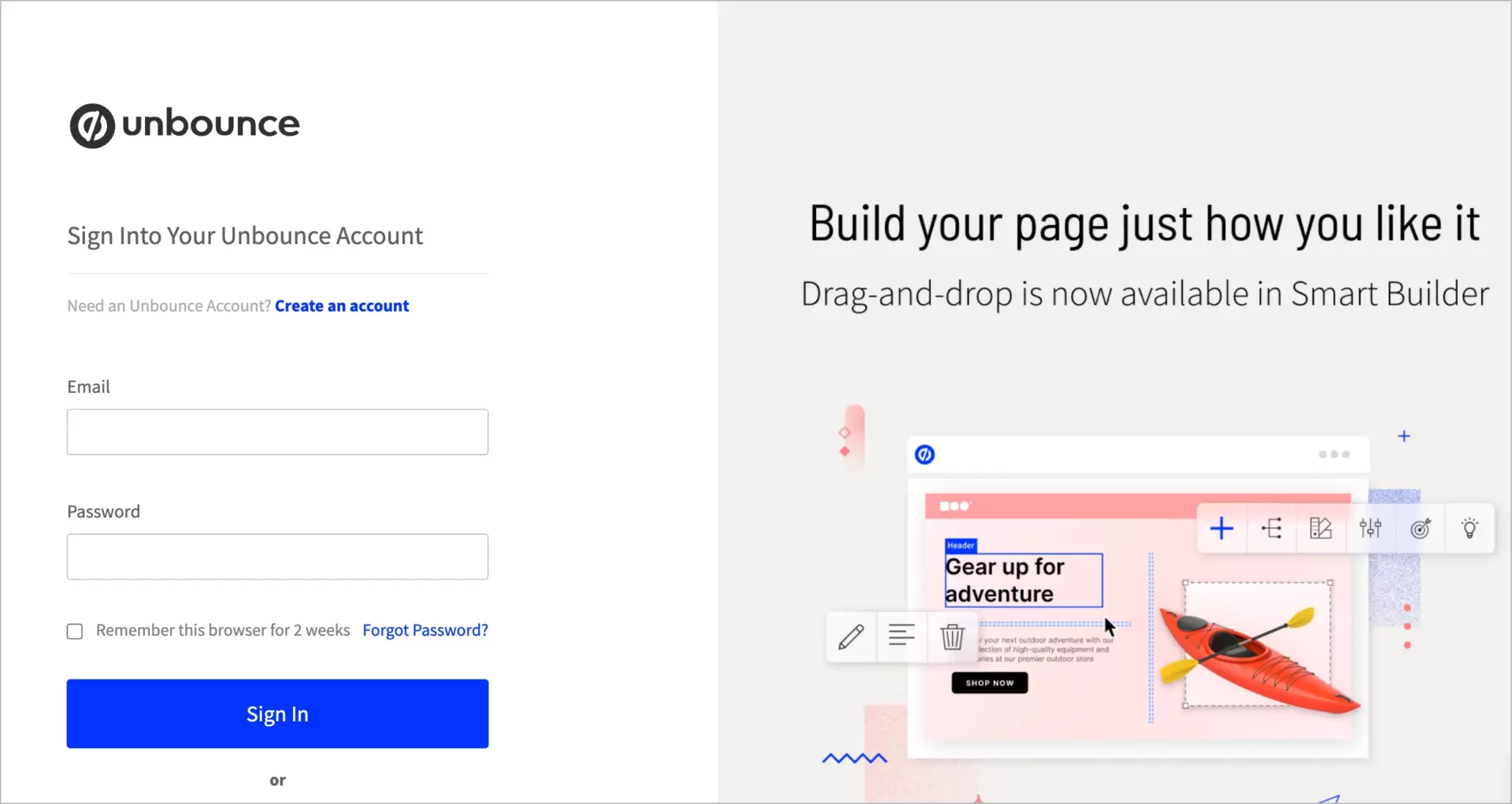
Craft Compelling Call-to-Action (CTA) like Calendly
Your CTA should be prominent, clear, and action-oriented, encouraging users to sign up. Bet on short form instead of long ones. “Sign-up” sounds far better than “Register on the platform”.
For inspiration, check out how Calendly does it. The wide blue button with the simple “Get Started” standing out from the white background is actually all they need.
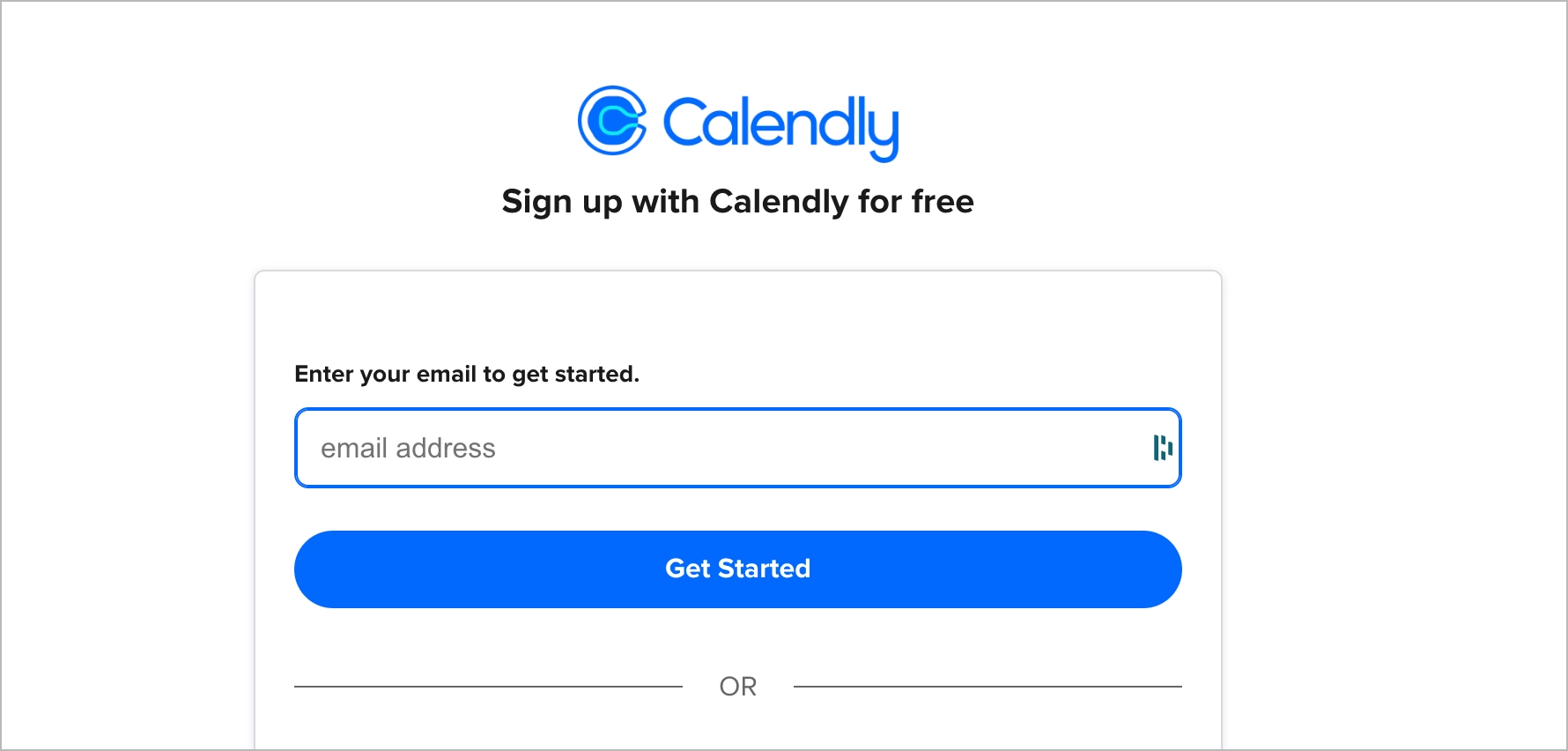
Bet on Minimalist Design like Geckoboard
Keep the design simple and distraction-free, focusing the user’s attention on the sign-up process. If the user is charmed with too many visuals, he may forget to… click “sign-up”!
A good idea is to enrich your sign-up form a bit with some icons like in the below Geckoboard example. It’s really minimal landing page, even if it doesn’t look so!
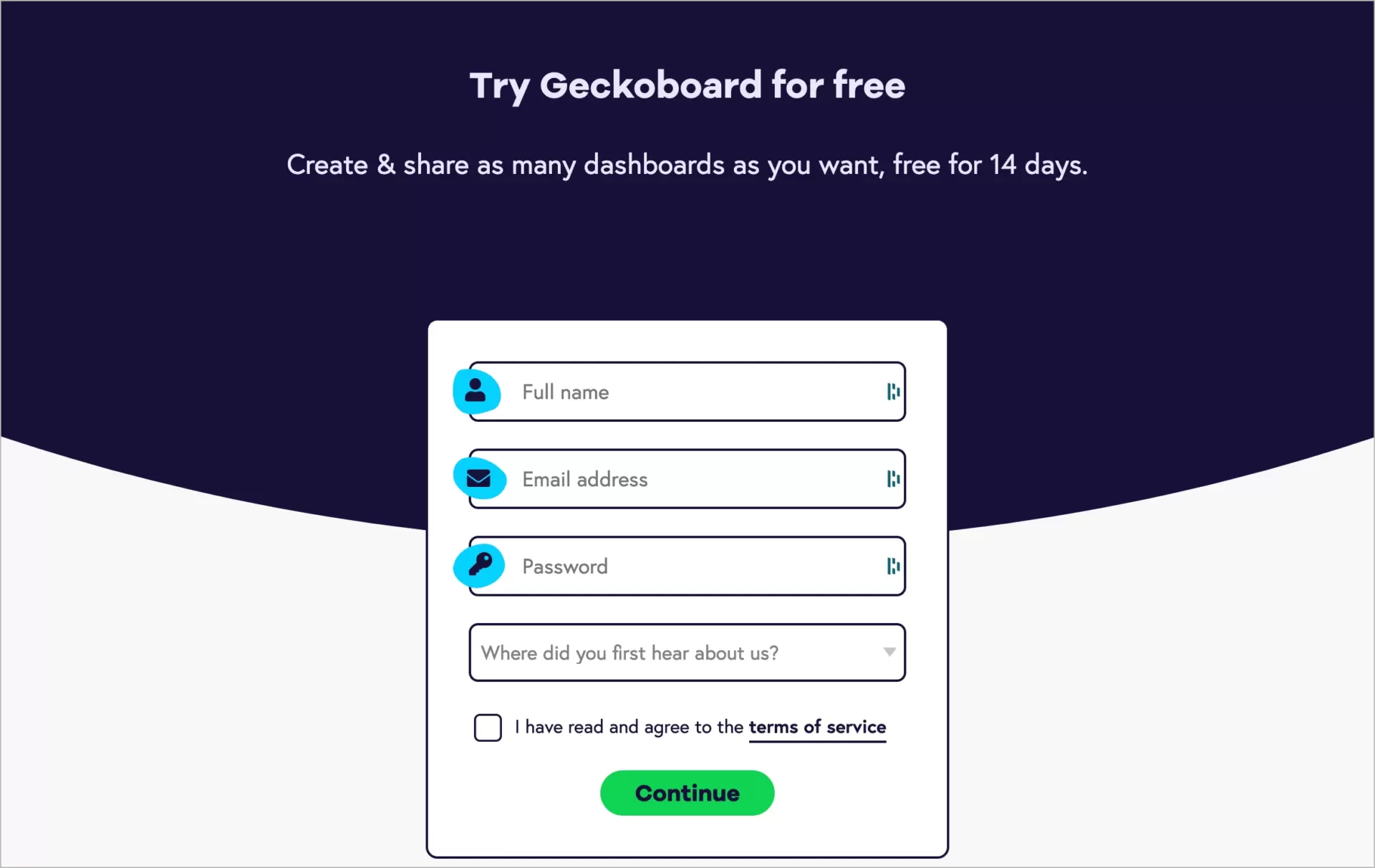
Lure with Engaging Visuals like Localize
Regardless of the above, every successful landing page should be visually appealing. If you need visuals, use only high-quality images or graphics that are relevant to your product or service and resonate with your target audience, but, at the same time, remember not to overwhelm the user.
The example below would be perfect if the image was closely related to the company type. Localize offers an automated translation solution, and it’s not clear how the picture on their sign up landing page corresponds with their DNA. Nevertheless, it’s well-placed and gives the page some visual appeal.
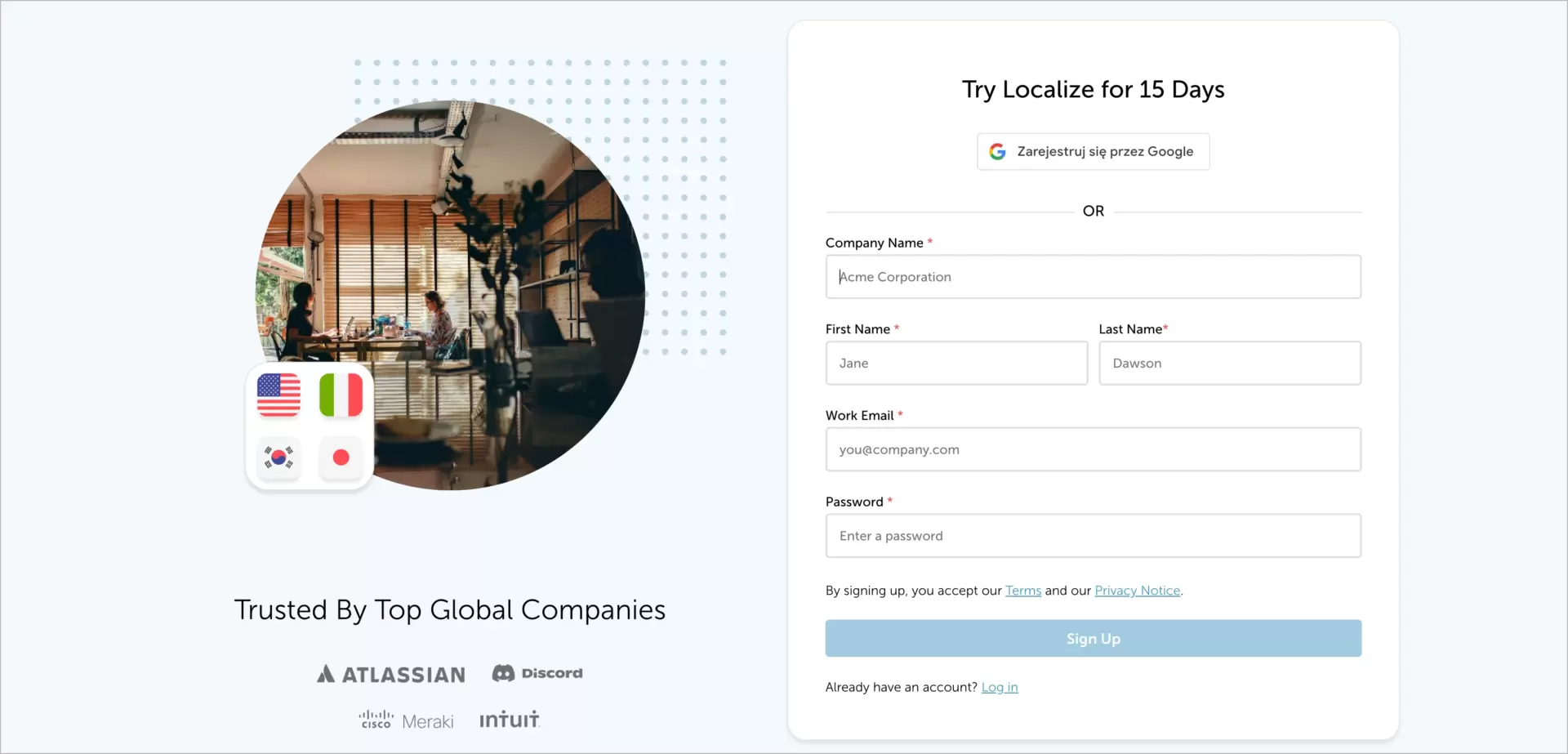
Make use of Urgency and Scarcity like Landingi
If applicable, use elements of urgency or scarcity, like a countdown timer, to encourage immediate sign-ups. Landingi implemented it well in their landing page for End of Year Sale:
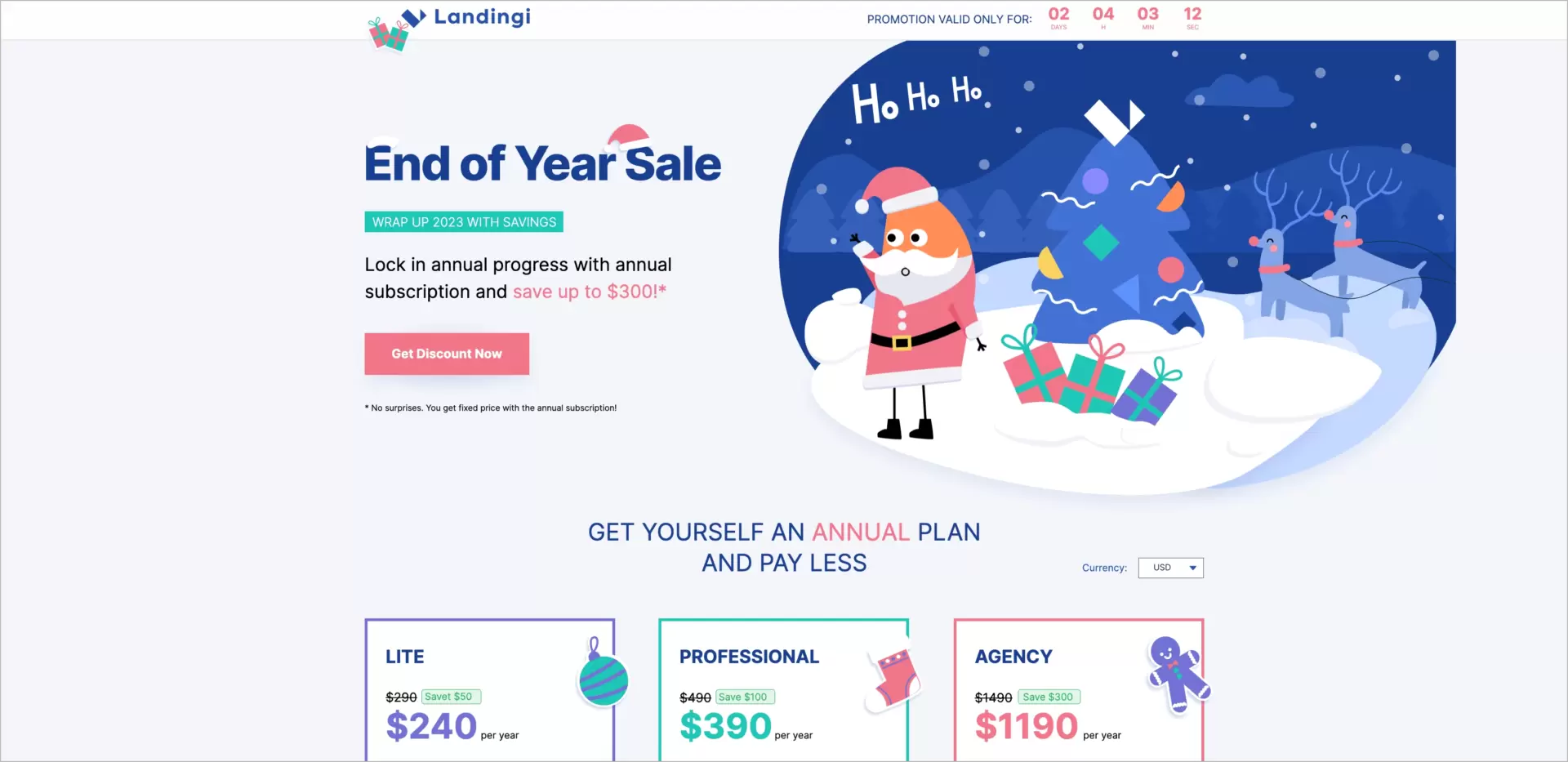
Optimize Forms like Disney
Make the sign-up form as simple as possible. Only ask for essential information to reduce friction. Keep in mind the purpose of your sign-up page, which is to provide easy and quick access to the platform or resources.
Disney is aware of the above. Their form starts with one field requiring minimal effort from the users. More information is required in the next steps when they are more engaged after filling in the previous one. Desire for getting access is still increasing with each step. Good job!
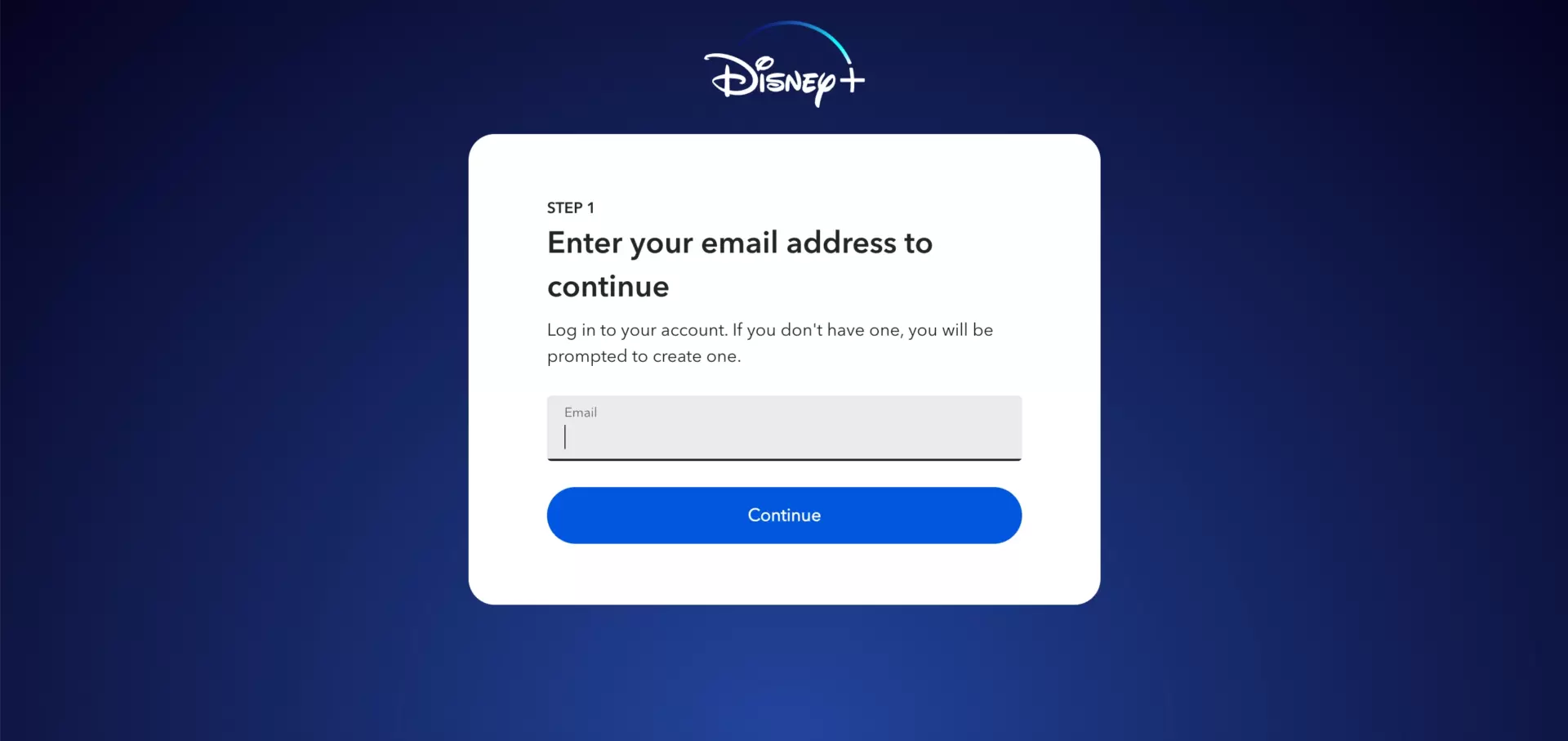
Ensure Mobile Responsiveness like Omnisend
Make sure your landing page is fully responsive on all devices, especially mobiles. Too many visuals may cause page loading issues and affect form readability. This is why Omnisend goes with such a simple layout:
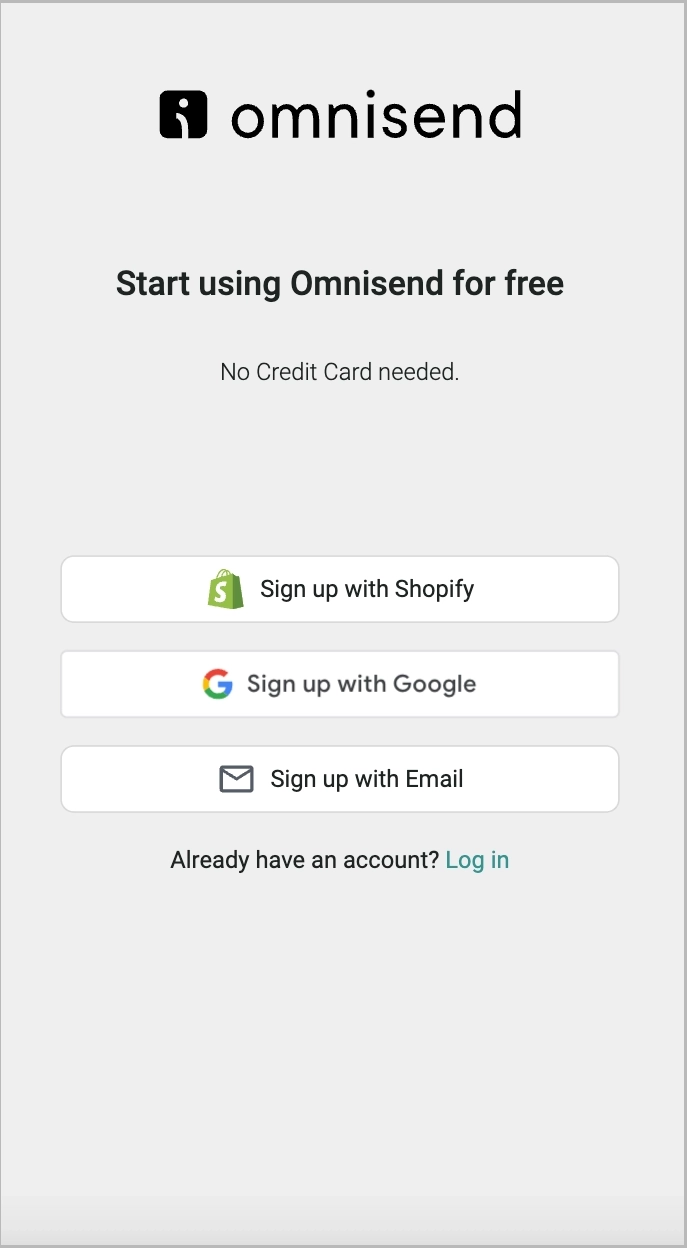
Assure Privacy Protection like Grammarly
Include privacy statements or links to your privacy policy to reassure users about the security and confidentiality of their data. Links to necessary documents below the form are fully sufficient. As an illustration, the landing page by Grammarly:
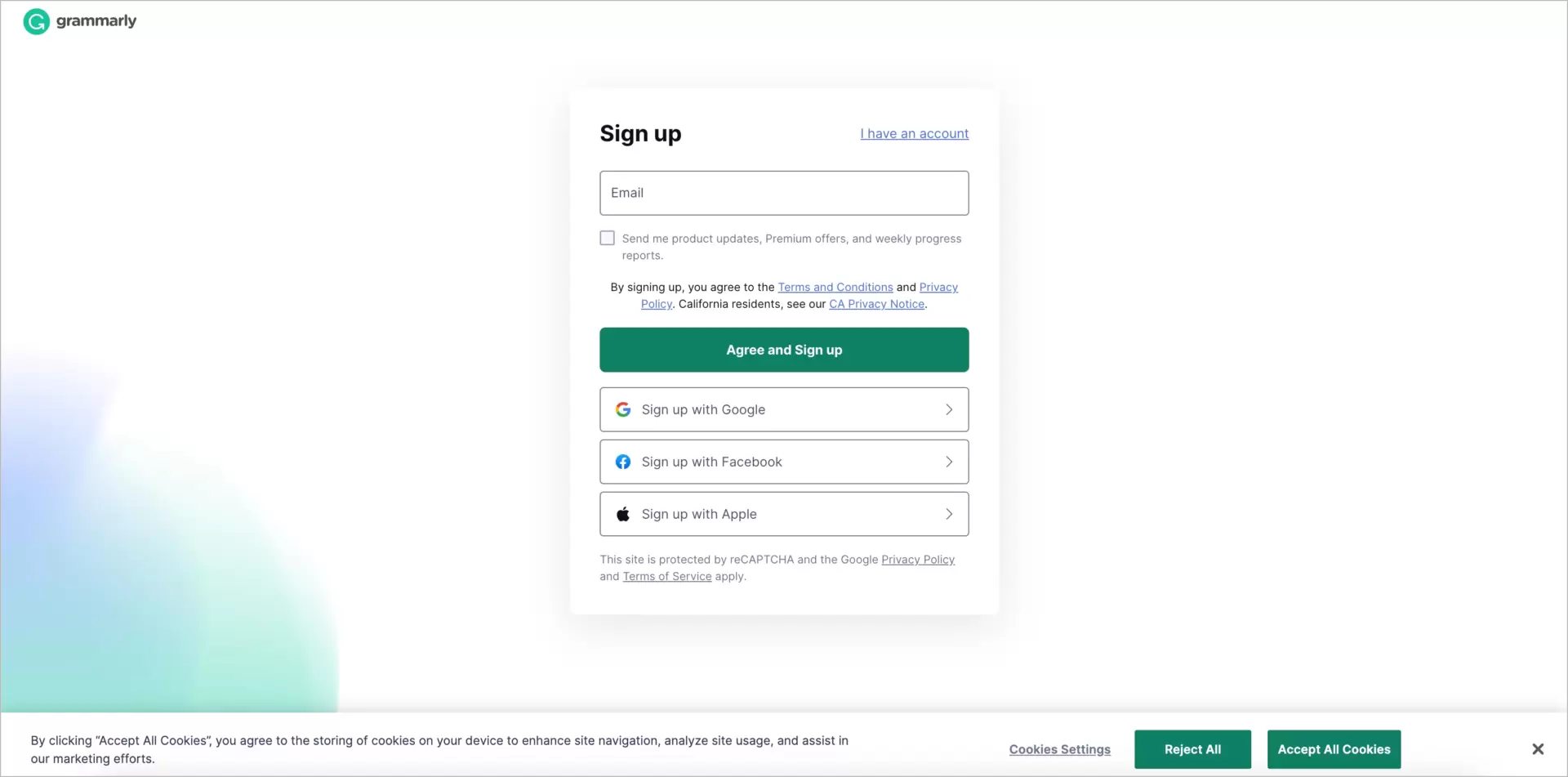
Utilize Social Proof like Zapier
If possible, include testimonials, reviews, or logos of well-known customers to build trust and credibility. It may strengthen the motivation for signing up.
Zapier incorporated it in their headline. It states that the platform is used by millions of people around the world, which means it’s credible and worth signing up.
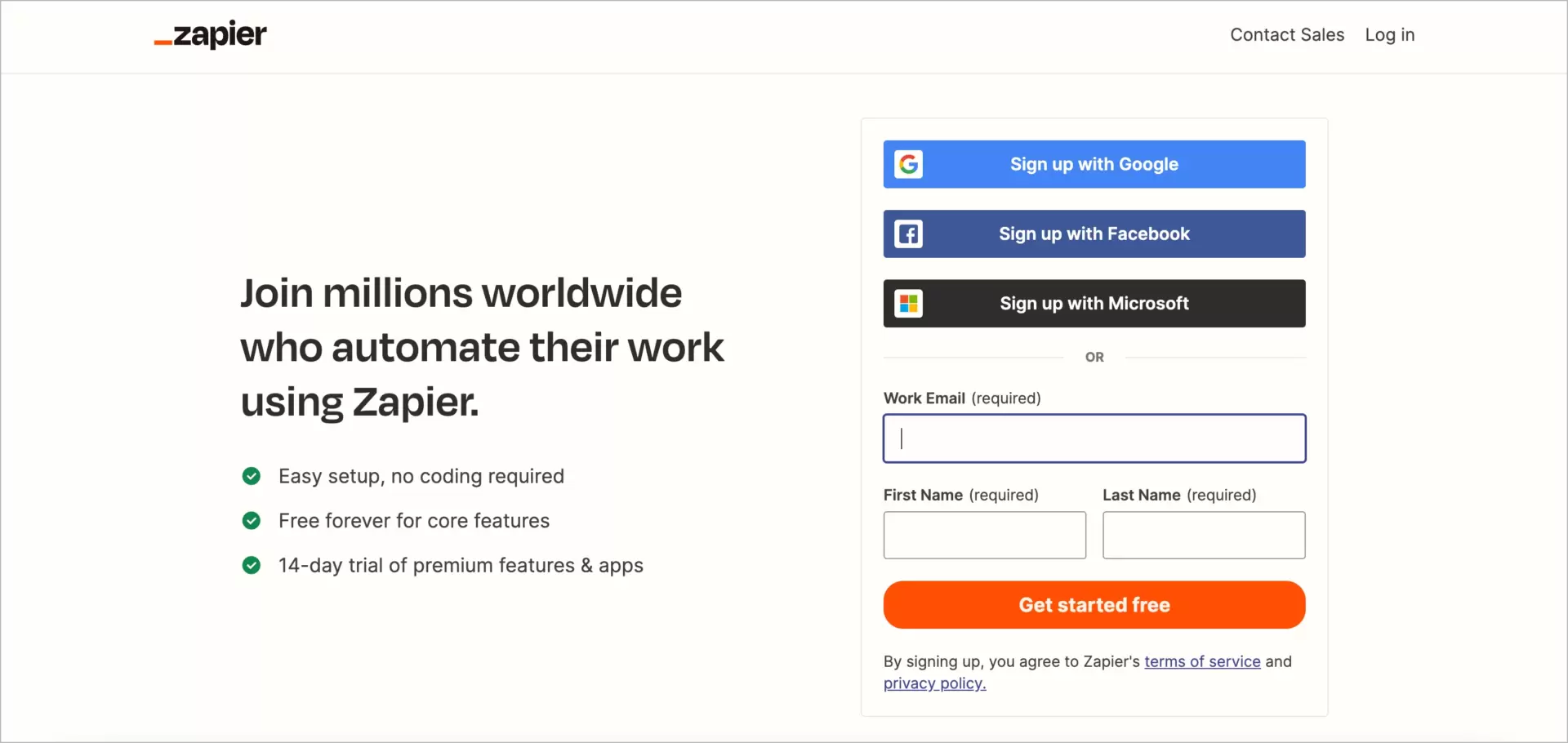
Benefit from A/B Testing like Landingi
Regularly test different elements (like headlines, forms, CTAs, images) and site versions to see what works best with your audience. Scroll down to the first of our examples and see which landing page variant turned out to be the best-converting one for Landingi.
According to MetricHQ, the average SAAS sign-up CR is 2-5% (P. Arora, Sign Up Rate, 2022), and this score is similar to a few other highly competitive industries. It may not be bad if you have tons of traffic, but you should aim higher. The above tips should help you to convert more visitors and get more leads for your business.
Get 111 Landing Page Examples—The Ultimate Guide for FREE
10 Examples of Best Sign-up Landing Pages
Below you can find 10 best examples of sign-up landing pages in 2023. If you spot one ideal for your company, keep in mind that you can easily build very similar pages with Landingi. Just a quick look at two random sign-up landing page templates available in the platform:

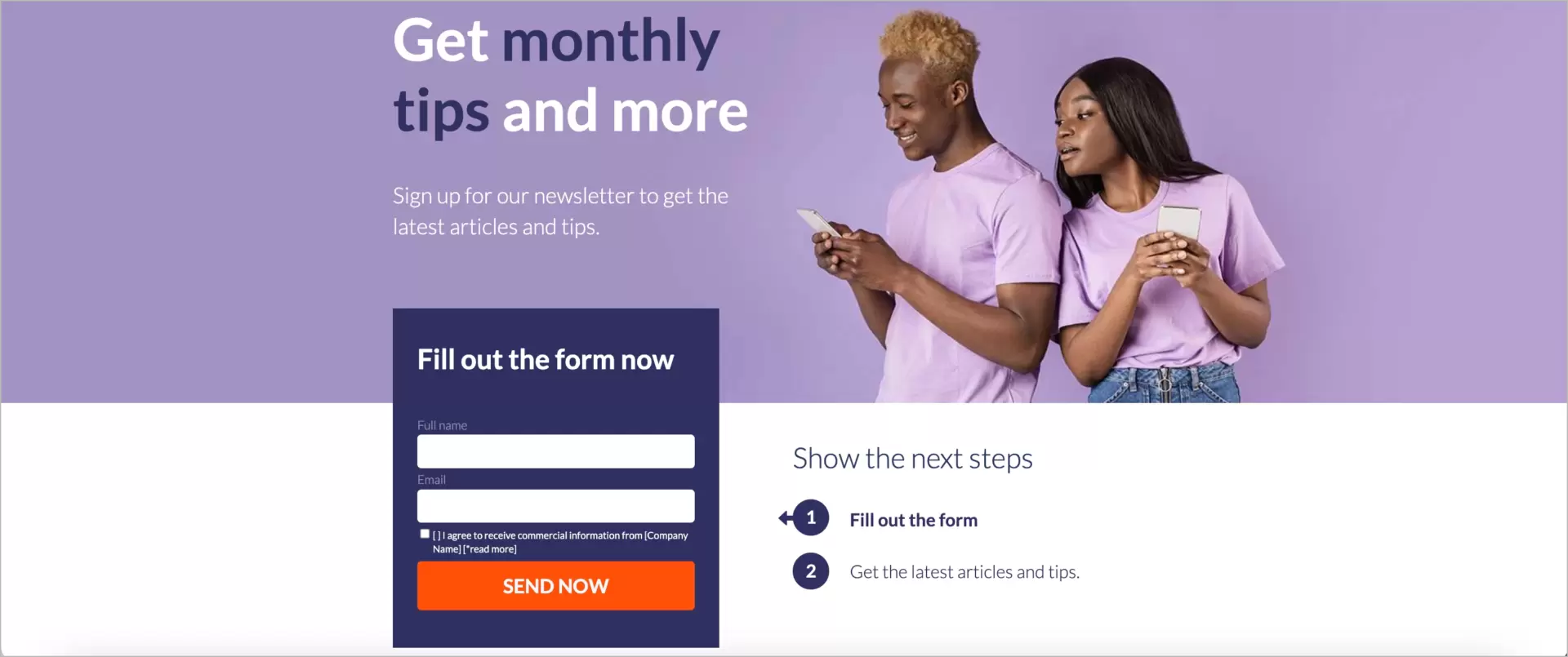
Now, let’s go ahead with the examples!
1. Landingi
Landingi is not only a no-code landing page builder but also a digital marketing platform for creating content with AI, tracking conversions and microconversions with built-in analytics, and performing A/B testing.
Landingi’s sign-up page takes advantage of the lion’s share of best practices we’ve discussed earlier.
Pros:
- Well-structured landing page design with action buttons on the left and persuasive elements on the right.
- Sign-up alternatives (Google and LinkedIn) to bypass form completion, which shortens the process to the max.
- Trust badges, big names and numbers visible at first glance to ease the last step for those who are still on the fence.
- Language of benefits (more leads, maximize sales) used in the headline instead of a features list that speaks nothing (e.g., create a landing page)
Cons:
- A bit too much bolding – it would be better to bold only one or two key values to make sure potential customers won’t overlook them.
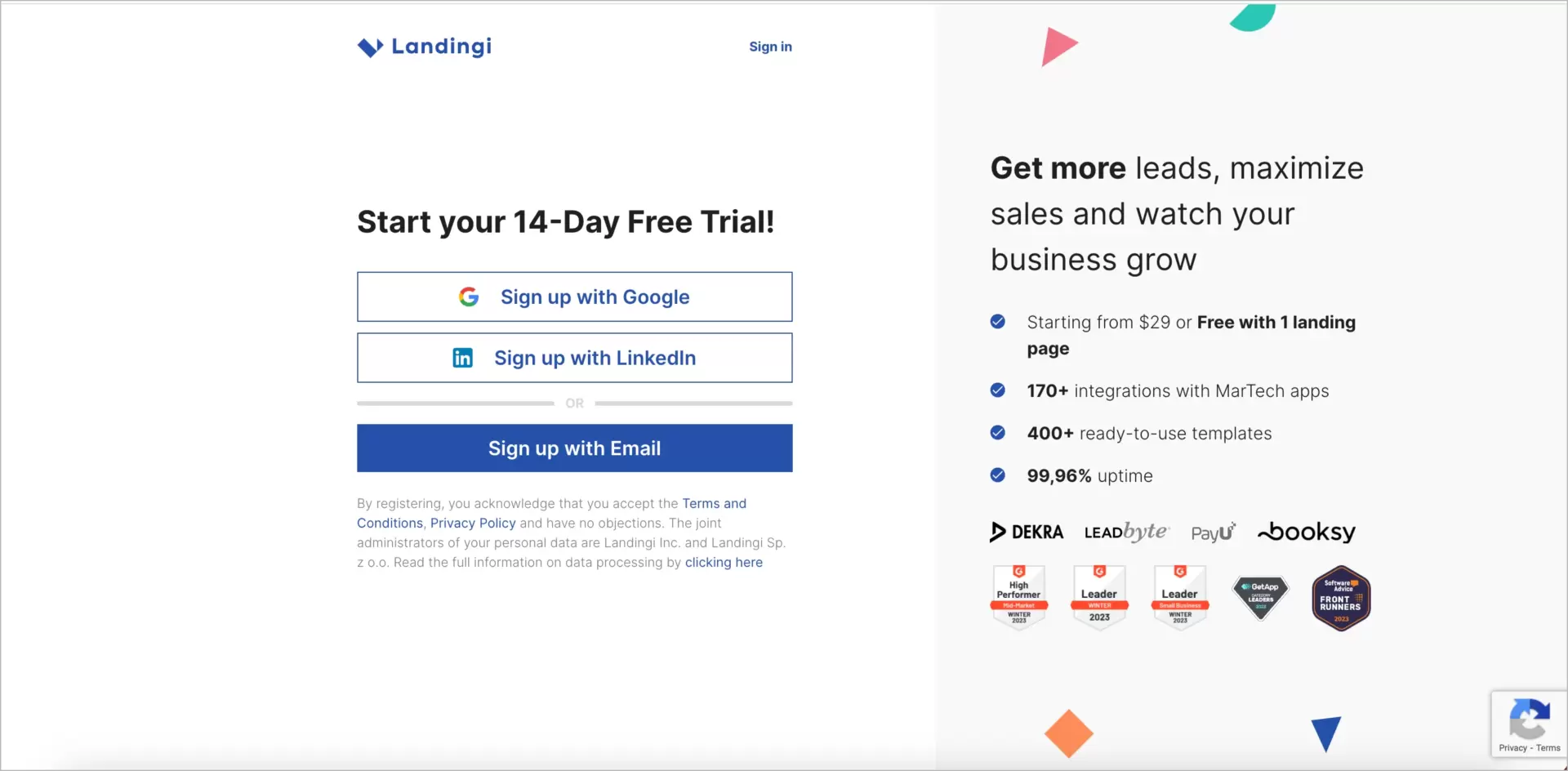
2. MaintainX
MaintainX is a company offering a mobile-first platform for industrial and frontline teams to digitize work orders and procedures, enhancing maintenance operations and compliance management.
Their registration page is well-balanced in all aspects.
Pros:
- Optimized, properly exposed form with only necessary fields.
- Layout remains clean without going crazy with white surroundings.
- Stars and trust badges subtly build credibility and nudge towards a registration decision.
- No top-bar menu = no links to distract visitors.
Cons:
- Constant contact widget (live chat?) would be beneficial for those having issues or additional questions during registration.
- No unique value proposition is emphasized all around.
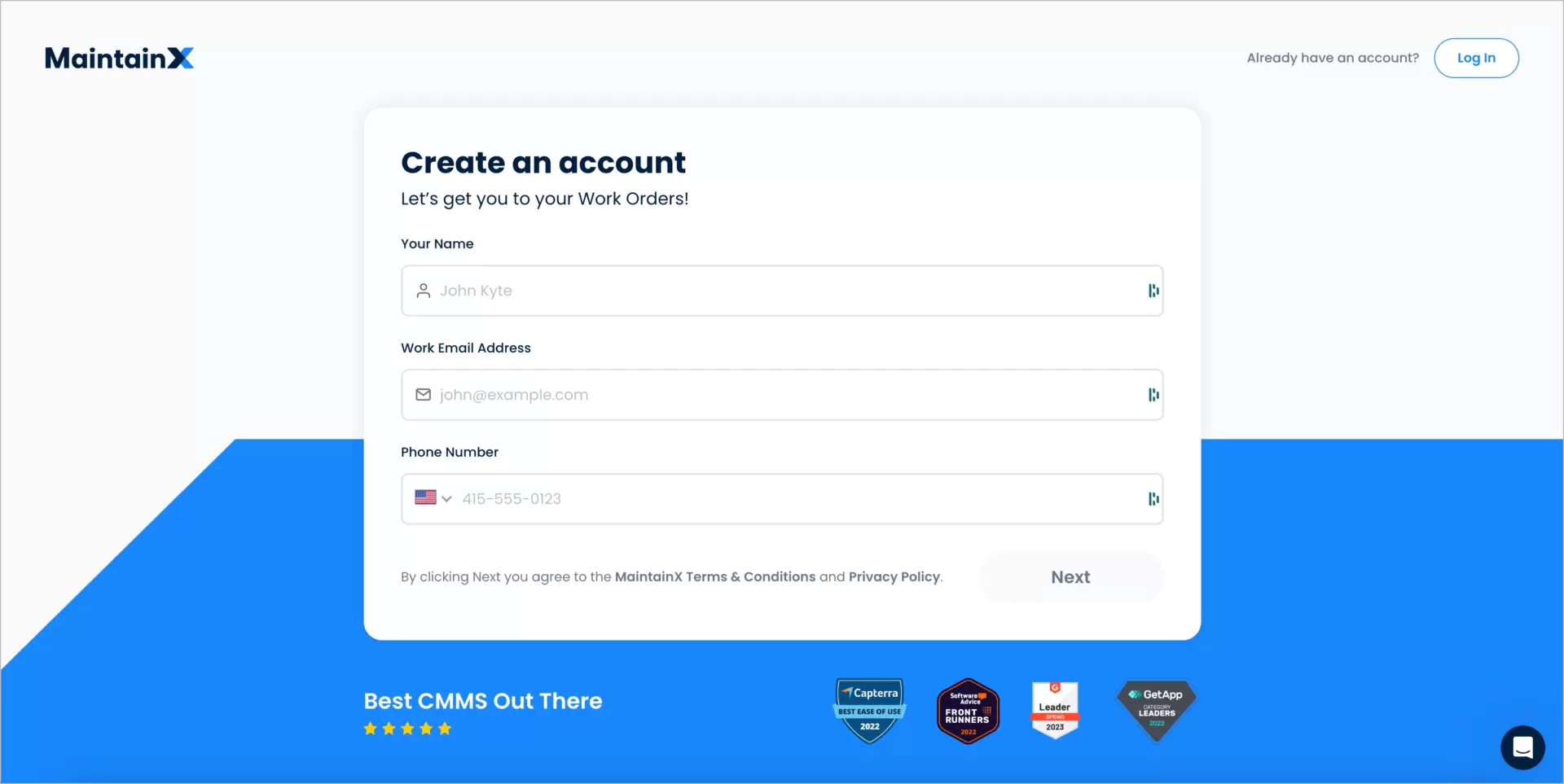
3. Google
This example could not be omitted. No need to introduce the company, so we can jump right to the nitty-gritty. Note that registering on the platform opens the door to signing up for a range of Google’s services (Google Analytics, Google Keyword Planner, etc.), so this step is really important.
This sign-up landing page isn’t a piece of art, but I’m sure that in the case of Google, it gets the job done.
Pros:
- Simplicity is the key: one button and only two necessary fields in the first step, encircled with enough white space. Everyone knows what to do.
- Subtle logo placement above the headline fully suffices to evoke the strength of the brand.
Cons:
- The form’s neighborhood is too empty. It almost begs on a bit of visuals to ignite some positive vibes and emotions.
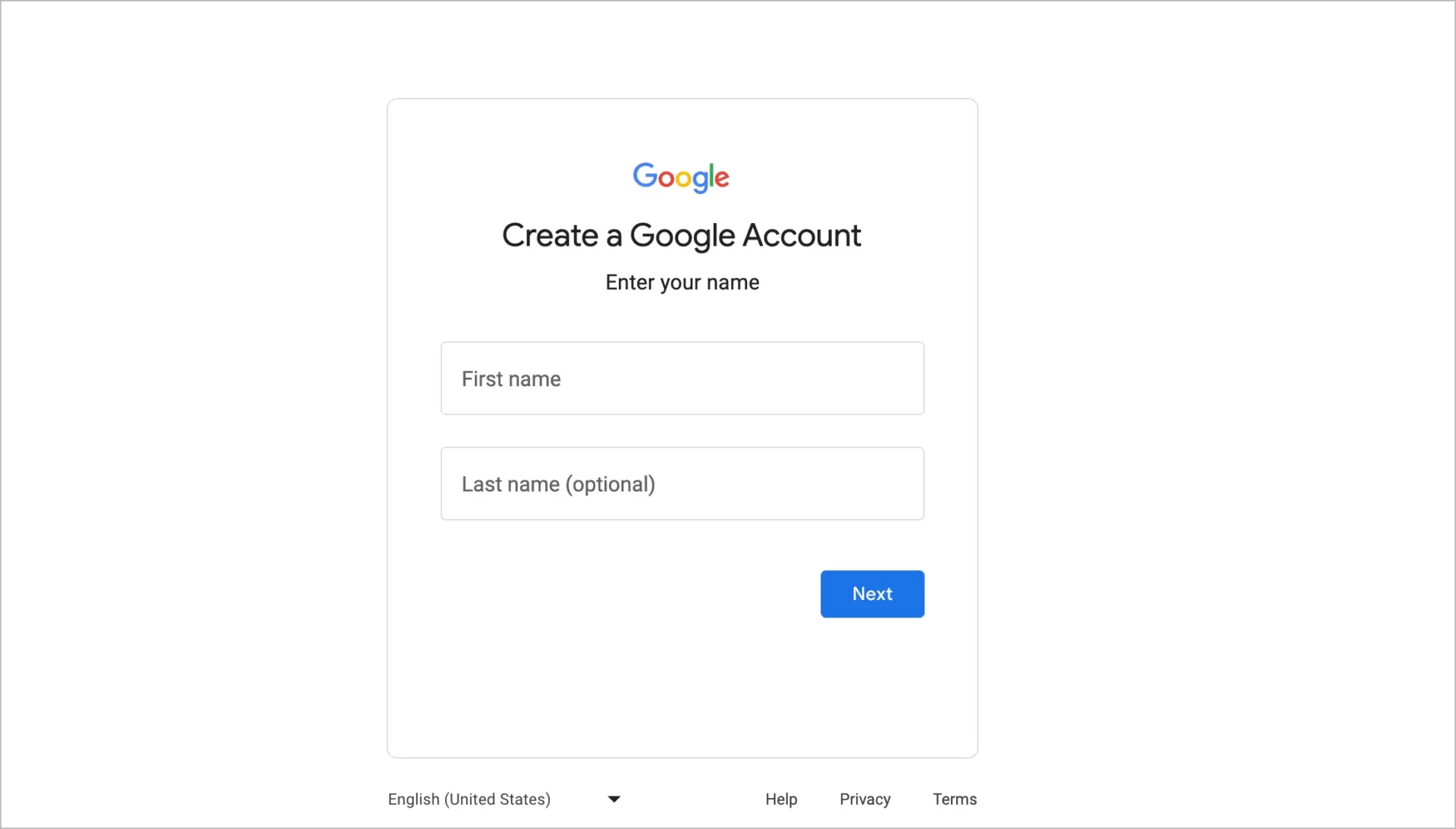
4. Discord
Discord is a communication platform primarily designed for gamers, offering text, voice, and video chat, as well as community-building tools, allowing users to create or join servers for various topics and interests. For example, it is used by the well-known Midjourney, as its primary platform for interaction and operation, where users can access and use its AI tools, particularly for generating advanced AI art.
Compared to the other landing pages presented in this article, this one is for sure the most creative.
Pros:
- Page structure is obvious for newcomers. Key elements are centered, and there are no distractions around (except for the one mentioned below).
- Background animated drawings are indisputably a masterpiece, but…
Cons:
- … this may divert visitors’ attention from the key point, which is the signup form!
- Form fields should be limited so as not to discourage the impatient (or not very determined to join the platform right now).
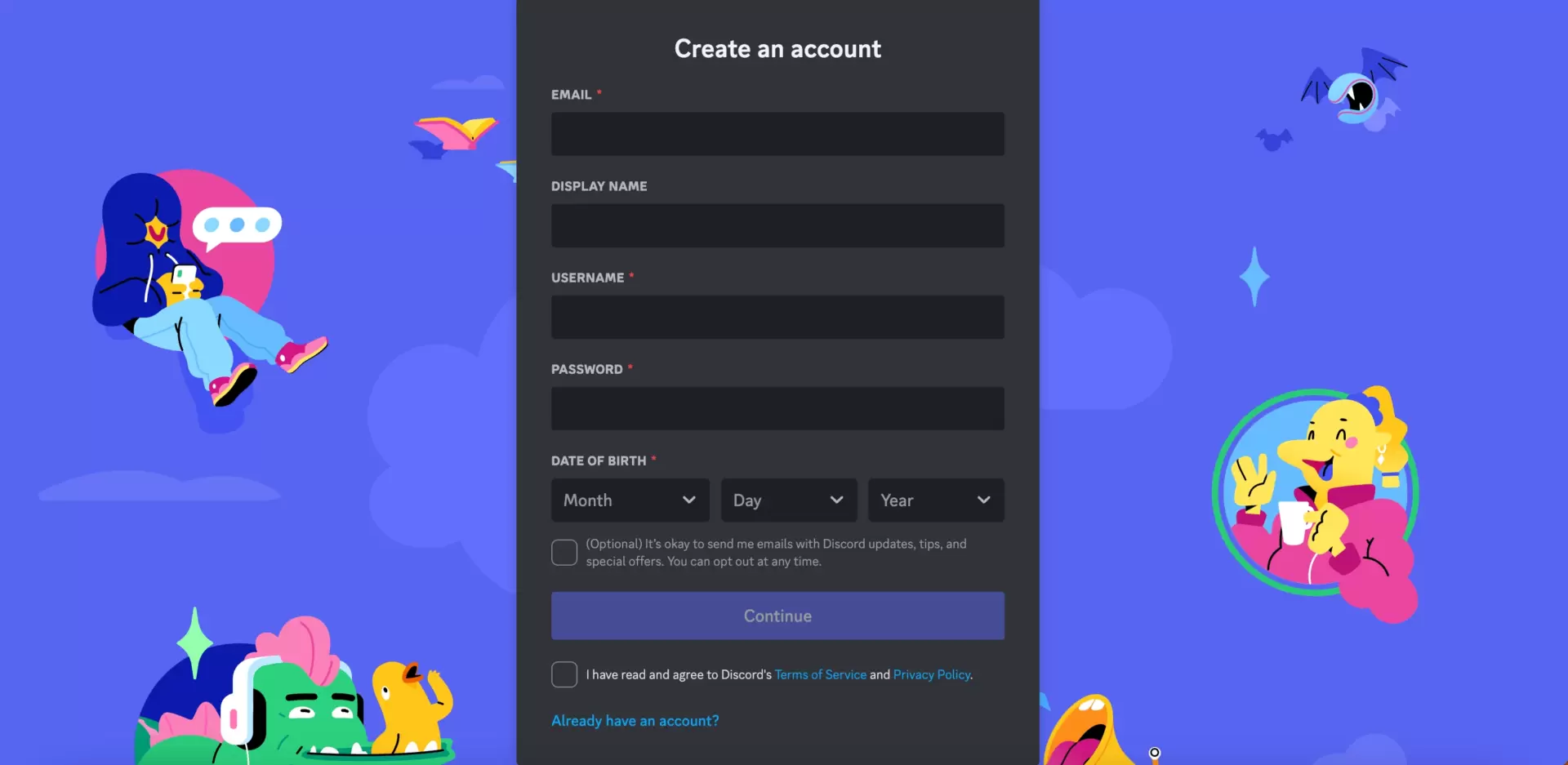
5. ClientSuccess
ClientSuccess is a company that develops a customer success management platform designed to enhance customer retention and growth for organizations.
Their sign-up landing page looks so fresh and vivid, but is it really effective one?
Pros:
- Powerful background color results in great first impression.
- Eye-catching, shining-green buttons make CTAs superbly visible.
- Personalized testimonial encourages visitors to fill in the form.
- Product values listed clearly on the left.
Cons:
- Long-winded form with…
- …the main CTA tucked away beneath the fold.
- Overload of links obstructs focus on the target action.
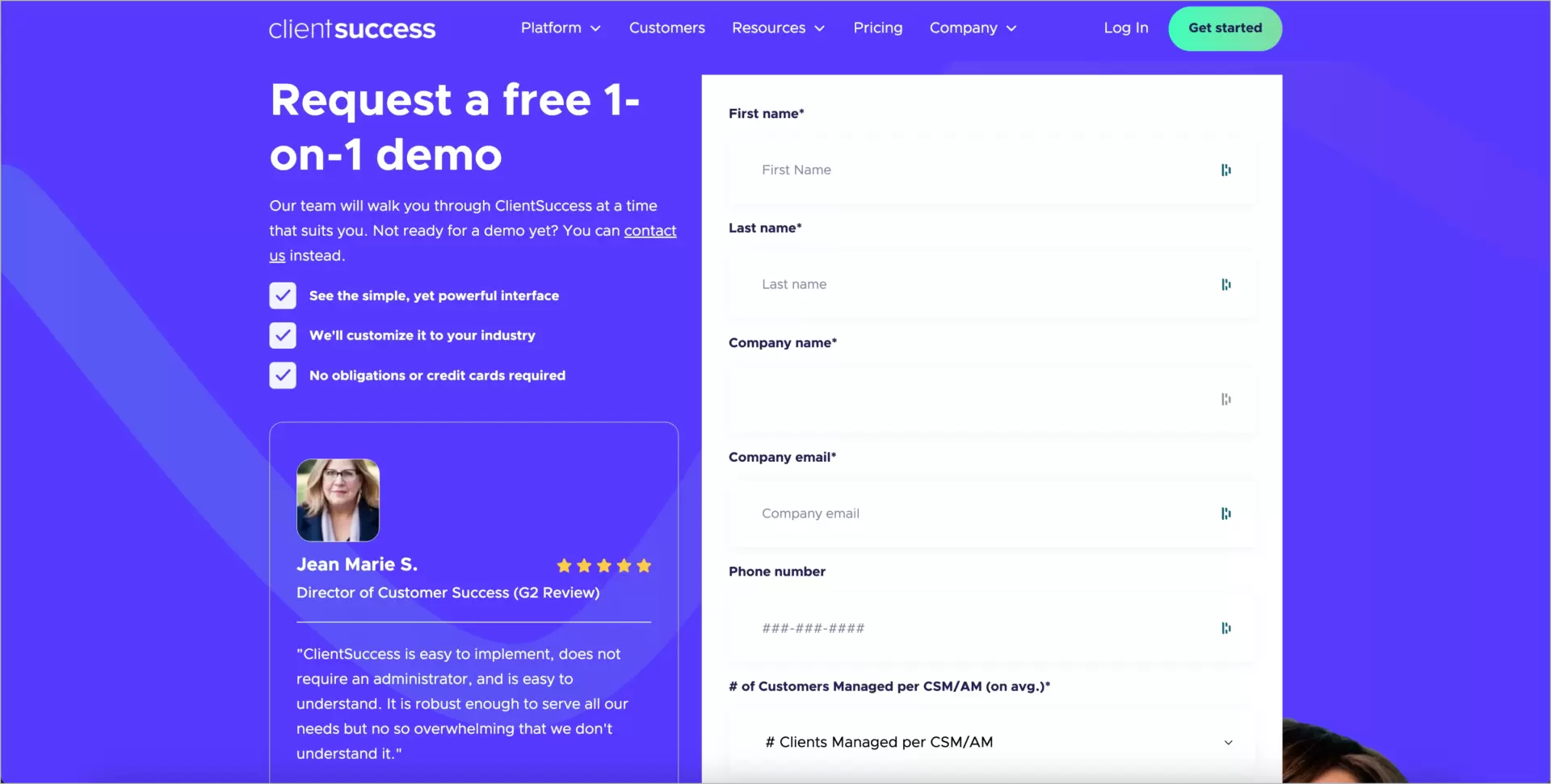
6. Semrush
Semrush is a comprehensive digital marketing tool suite that provides analytics and insights for SEO, PPC, social media, and content marketing strategies.
Their landing page could be a winner in the category “Simple Form”, as they limited not only a number of fields but also copy and disclaimers below the CTA.
Pros:
- Easy-looking straightforward form with fields limited to the max.
- Zero distractions in the neighborhood.
- Design enriched with a bit of color looks warm and more inviting.
Cons:
- Unused space around is ideal for some copy, UVPs, or testimonials.
- One or two compelling images could have a positive effect on those potential customers who are still unsure whether to sign up or not.
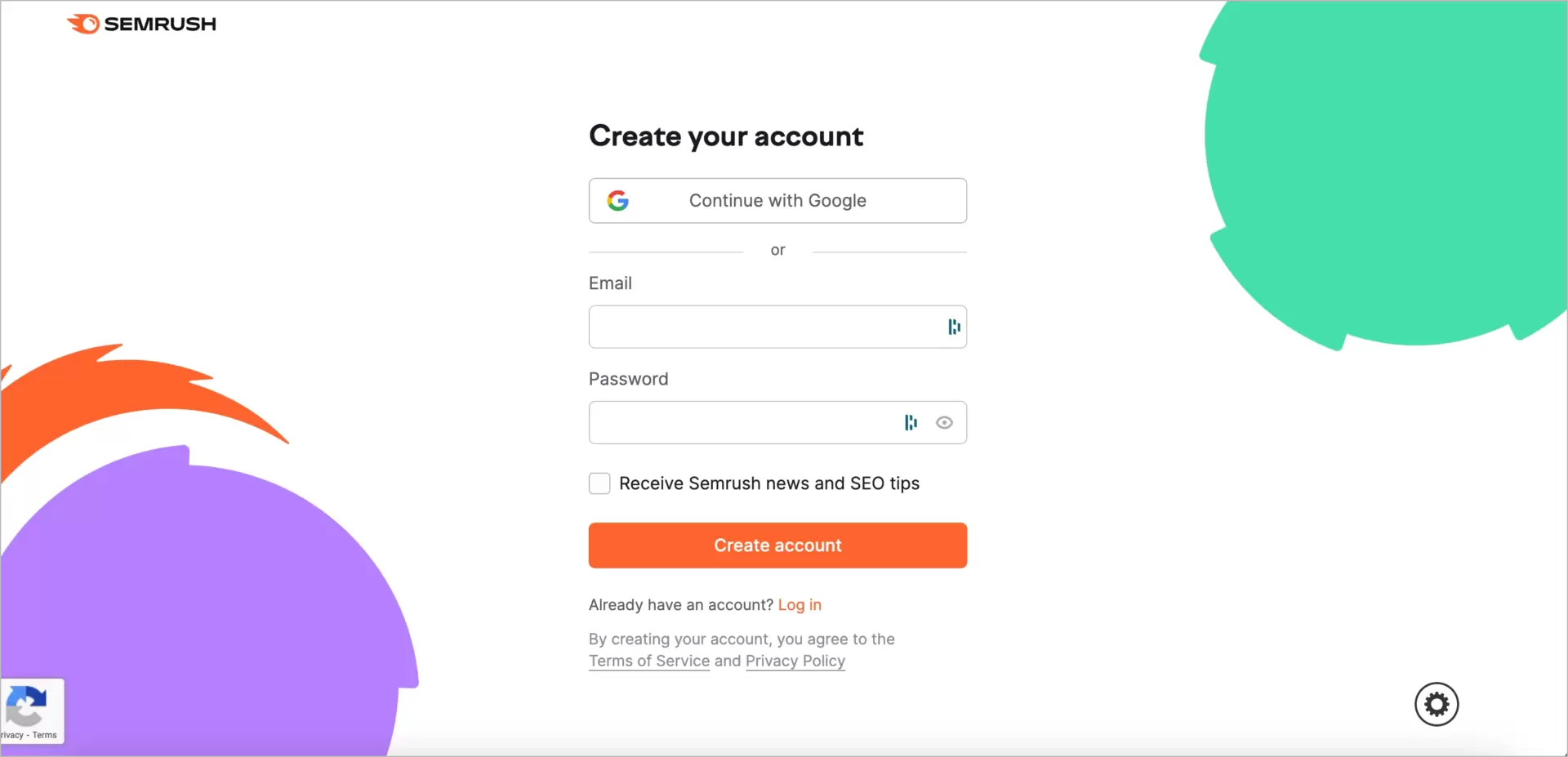
7. ActiveCollab
ActiveCollab is a project management and collaboration tool designed to help teams organize tasks, track work progress, and manage projects effectively.
This is the first landing page in our overview with an image blended into the background. In contrast to a few others, it appears quite intriguing, doesn’t it?
Pros:
- The image integrated into the background, as well as the vivid violet on the form, catches the eyes in seconds.
- One button and one clear CTA – minimalism at its finest.
- A well-employed header emphasizing the core value (work control) of the solution.
Cons:
- Product features on the left should be more specific and bear values they convey to the target audience.
- Thin font for the above may cause overlooking listed features.
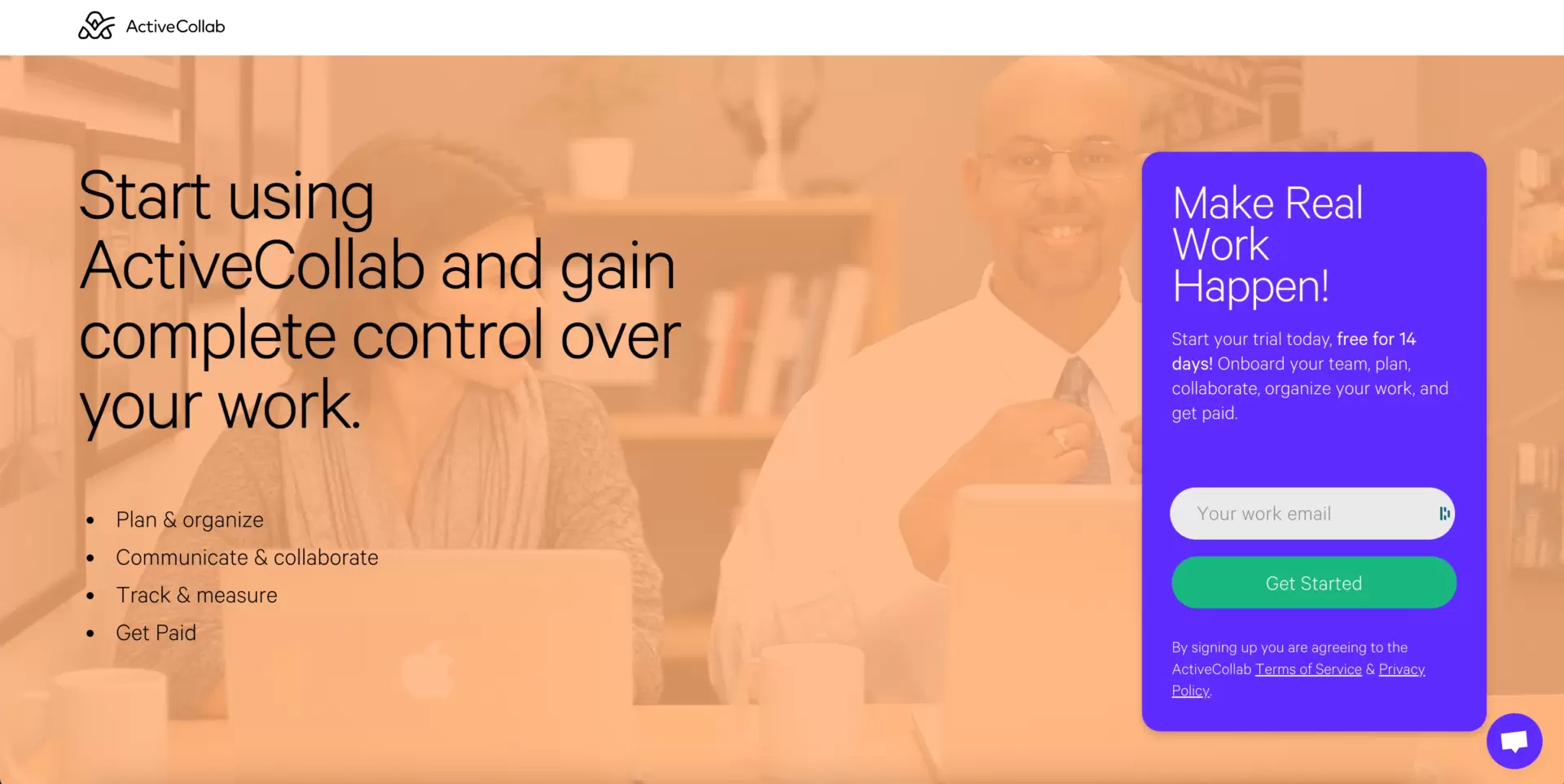
8. GetResponse
GetResponse is an online marketing platform that provides tools for email marketing, landing page creation, webinar hosting, and marketing automation.
Undoubtedly, one of the best sign-up landing page examples that makes the most out of a variety of elements (headline, features listing, icons, etc.).
Pros:
- Form restricted to essential fields.
- Bright-yellow CTA nearly shouts “Click me!”
- Headline covering UVP highlights that GR is a versatile marketing platform to grow business, not a one-purpose e-mail marketing tool with limited functions.
- Features list emphasizing integrated website or landing page builder, funnel editor, analytics, and automations, reinforces the above-mentioned messaging.
Cons:
- Some features seem not worth mentioning, as they steal the attention from the most crucial ones. I would rather limit the list to no more than four or six items.
- Feature names could be extended to briefly mention marketing or business benefits they add to users.
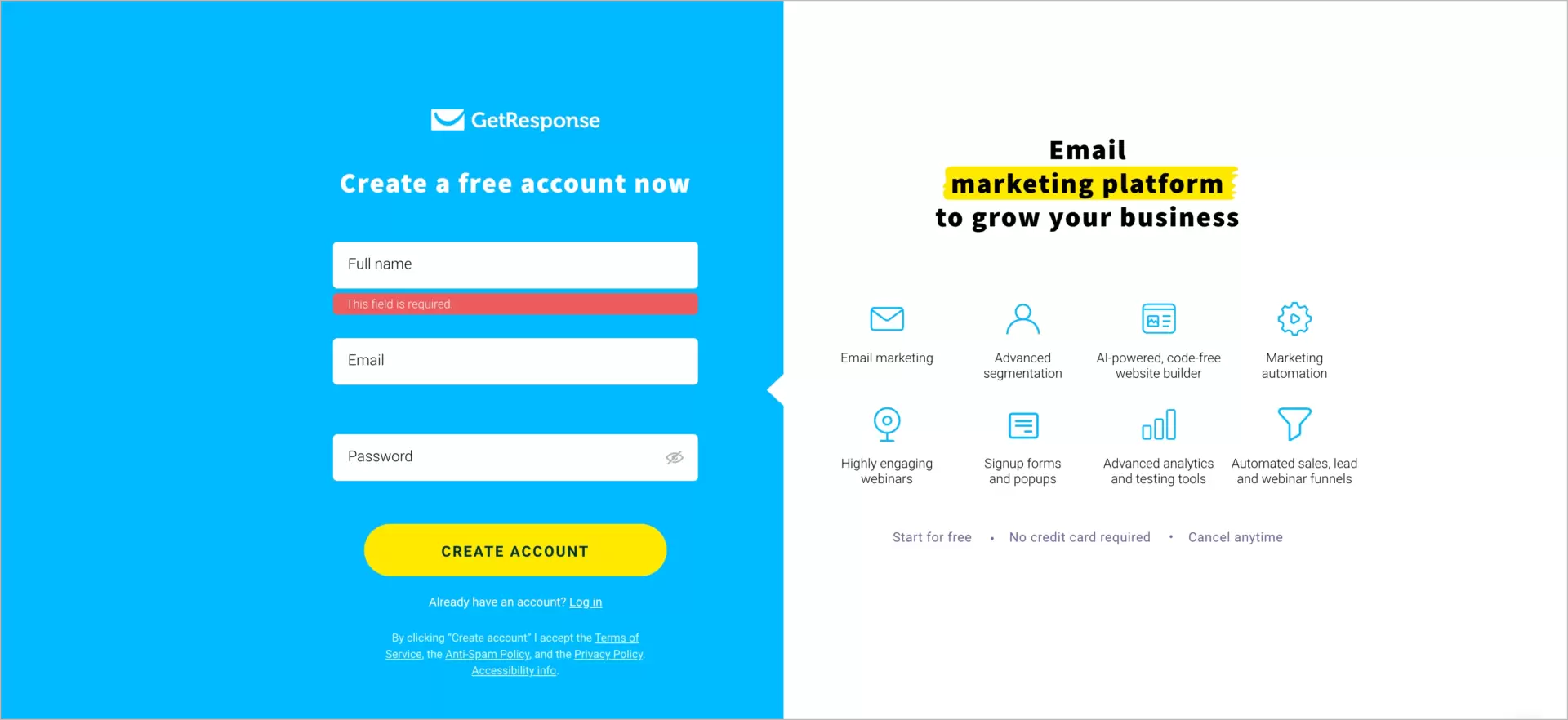
9. Macy’s
Another case where landing page design is almost… absent. And honestly, another big player who needs no introduction. So, what are the advantages and weak spots of their landing page?
Pros:
- Core registration benefits listed on the right.
- Discreet yet powerful company logos in the top section remind users of everything they associate with the brand.
- No links and no top menu enable clear focus on the signup form.
Cons:
- Lead capture form with so many fields looks like a beast for those who value their time.
- CTA hidden below the fold can’t play its role effectively.
- Too much messaging (additional offers, disclaimers, data statements, etc.) may cause confusion. It’s not so clear if the user signs up for the Macy’s store or only joins the Macy’s Star Reward program.
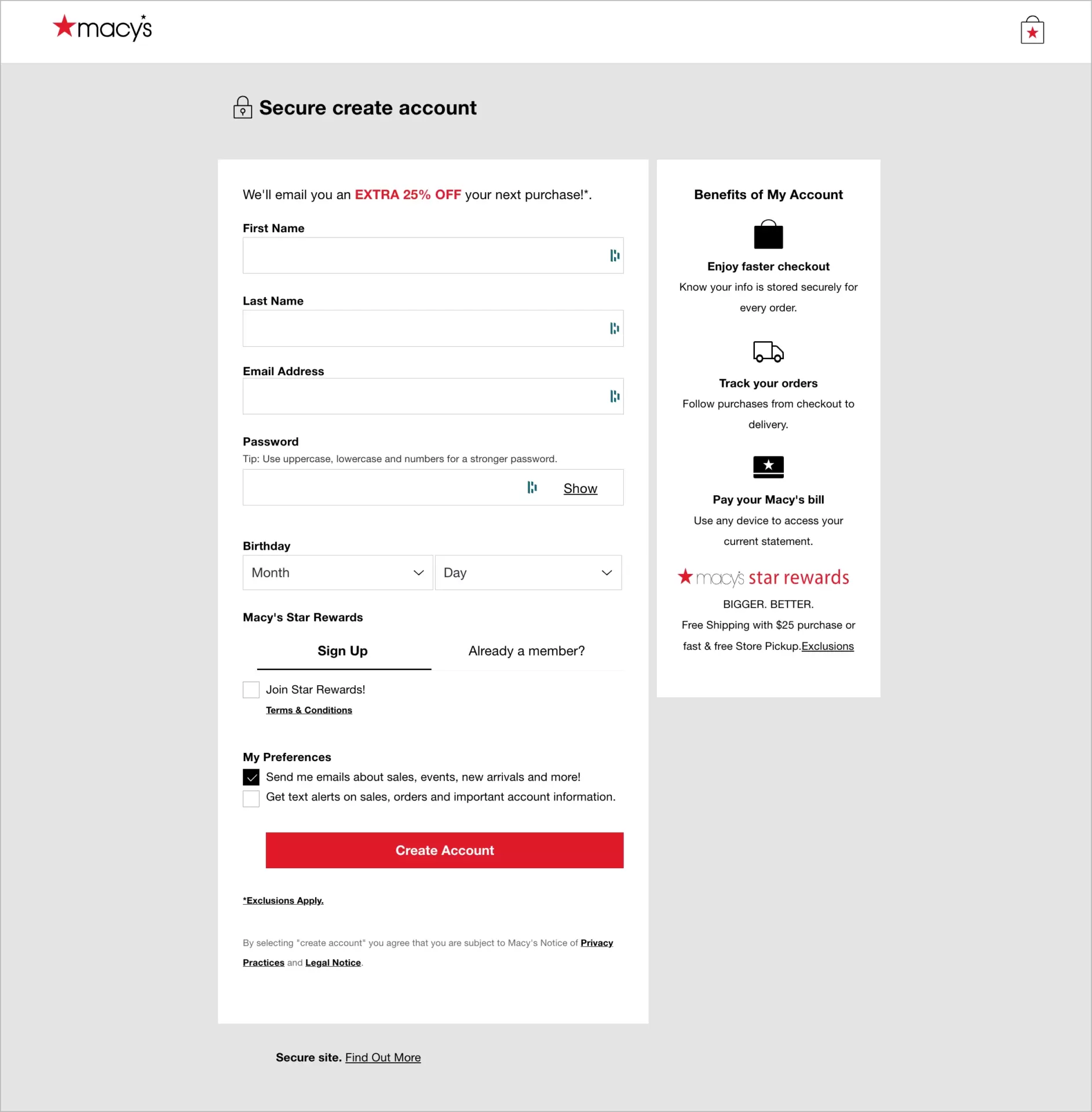
10. eToro
eToro offers a platform for trading stocks, cryptocurrencies, and other assets, with a unique feature of copy trading, allowing beginners to mimic the moves of experienced traders.
As you can see somewhat below, their landing page is another strong player in the “minimalism” category.
Pros:
- Clear CTA standing out from the background. No space for confusion.
- Only necessary fields included + additional buttons for sign-up via Google or Facebook. Everything is as easy as possible.
- Though the layout may seem spartan, it works (and looks) perfectly on mobile devices.
Cons:
- Too many fonts mixed up, along with various formatting (colors, bolds, etc.), make the overall design a bit inconsistent.
- Highlighting UVP through visuals may convince visitors more effectively than the form itself (even if it would be a repetition of what they saw on the source landing page).
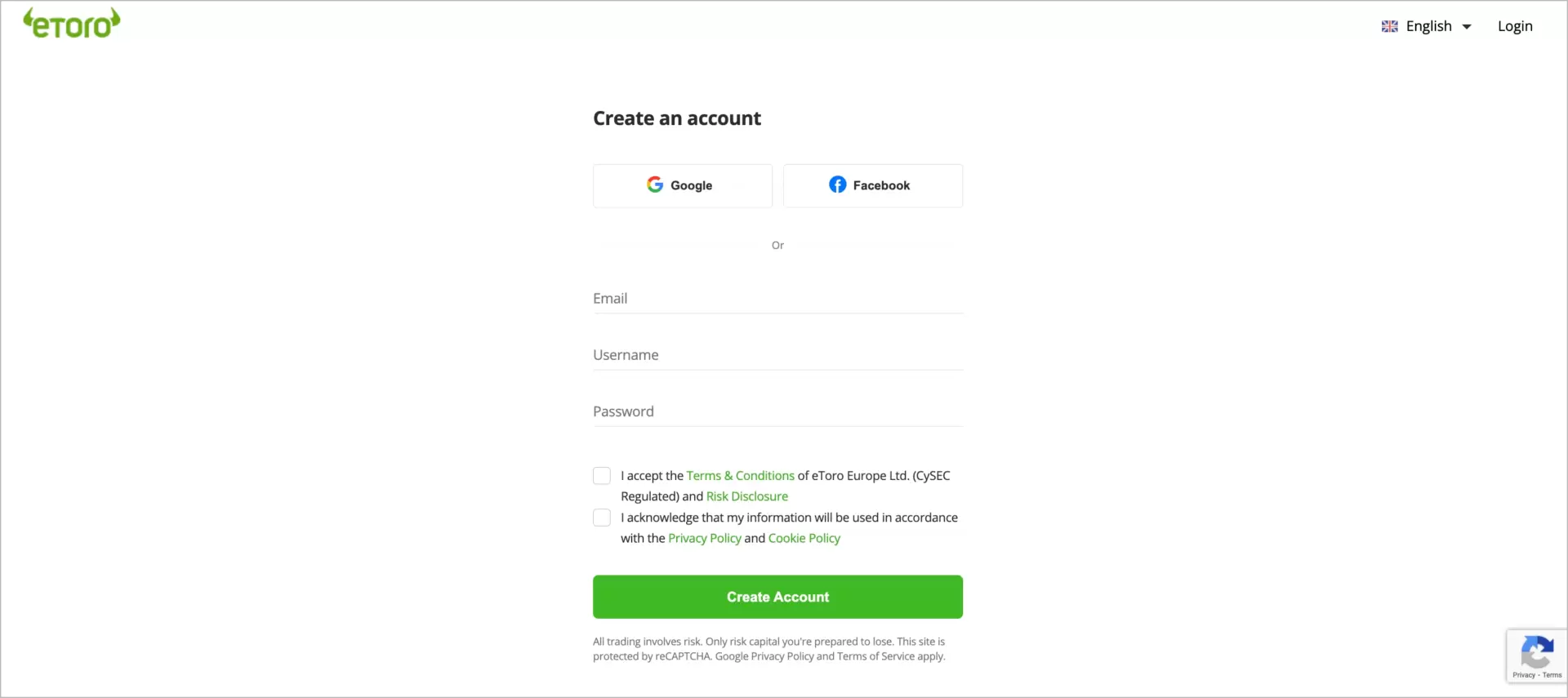
What to Avoid while Creating Sign-up Landing Pages?
While creating sign-up landing pages avoid excess of information, vague CTA, lack of mobile optimization, ignoring trust signals, and abandoning analytics and A/B testing stage. Let’s discuss it a bit more.
- Overloading with Information: A clean and focused design is crucial. Some studies indicate that pages with too much visual complexity can overwhelm visitors, leading to higher bounce rates, as they are perceived as less visually appealing (K. Reinecke et al., Predicting Users’ First Impressions of Website Aesthetics With a Quantification of Perceived Visual Complexity and Colorfulness, 2013).
- Complicated Forms: Long or complex sign-up forms can deter users from completing the registration process.
- Excessive Landing Page Design: Landing pages are known for their simplicity, and sign-up pages should be even simpler. Animated background or one image are OK, but don’t go crazy with visuals to keep visitors focused on the key action with is completing a registration form or clicking a sign-up button.
- Unclear Call-to-Action (CTA): Clear CTA can dramatically increase engagement, with a 371% boost in clicks and a 1617% increase in sales (A. Vara, 15 Call-to-Action Statistics You Need to Know About to Increase Your Conversion Rate, 2023). With this in mind, ensure your CTA is prominent and compelling.
- Neglecting Mobile Optimization: As Statista reports, over half of global web traffic comes from mobile devices (T. Bianchi, Percentage of mobile device website traffic worldwide from 1st quarter 2015 to 4th quarter 2022). A mobile-friendly design is not just beneficial, it’s essential.
- Using Excessive Jargon: While targeting non-experts, it’s important to maintain clarity. Overuse of industry-specific language can be off-putting. Aim for simplicity and directness in your messaging.
- Skipping A/B Testing: Regular testing is key to understanding what resonates with your audience. Sometimes our presupositions are wrong advisor – don’t take it for granted, verify!
- Ignoring Trust Signals: Trust elements such as customer testimonials and security badges are crucial for credibility. These elements can significantly enhance consumer trust in a business, especially in difficult niches with large cash flows like finance or real-estate.
- Failing to Utilize Analytics: Tools like Google Analytics are indispensable for tracking user behavior and refining your strategy. Without analytics, optimizing your landing page becomes guesswork. Before you try to convert visitors, you should first know who they are and how they behave on your landing pages. Only that way you can meet their expectations.
- Overlooking Page Load Speed: A fast-loading page is vital for retaining visitors. Google notes that pages taking more than 3 seconds to load have a significantly higher bounce rate (2016). Streamlining your site’s code and optimizing images are effective ways to improve load times.
Creating Landing Pages with Landingi
Can’t wait to build your own landing page for sign-up but you don’t know how to start? The process is more easy-going than you ever might have thought. Find the recipe below.
First, choose your landing page editor. Don’t buy pig in a poke, opt for proven solutions. You may choose one of the builders tested and recommended by Zapier, like ConvertKit or Landingi (H. Guinness, The 7 best landing page builders in 2023). These platforms are quite popular for a reason. They are reliable and equipped with all the features you need to streamline the creation process and accomplish your business or marketing goals.
Second, decide whether you want to create your new landing page from scratch or save time and utilize pre-made templates. Landingi has on board over 300 conversion-driven landing page templates and additional ones for sections and pop-ups. After choosing a kit that fits your needs the most, you may personalize it in every detail. No obstacle to making creations similar to those great landing page examples covered in this article.
Third, fill your landing pages with all the necessary elements. In Landingi, you can:
- generate content and basic SEO for your pages with AI Assistant, which accelerates the process as much as possible,
- make use of the abundance of free images available in the integrated Unsplash gallery and,
- refine your pages with forms, buttons, and widgets like counters, sliders, calendars, etc.
Finally, ensure you’ve created a great landing page not only in terms of design but at the same time generating leads or/and revenue for your business. In Landingi, you can optimize published landing pages based on detailed user behavior data (including clicks, views, scrolls, etc.) acquired from built-in EventTracker, which serves as a Google Analytics alternative for landing pages. You may also check with A/B testing which variant of your page (or which element) performs better. This way, you’ll be able to identify the most efficient solutions for your business niche.

